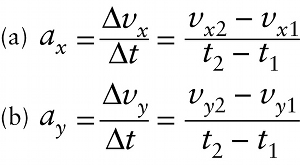Components of the acceleration vector (3-10)
Question 1 of 5
Question
x component of the acceleration vector \boldsymbol{\vec{a}}
{"title":"x component of the acceleration vector a","description":"Correct!","type":"correct","color":"#99CCFF","code":"[{\"shape\":\"rect\",\"coords\":\"49,39,72,64\"},{\"shape\":\"poly\",\"coords\":\"82,133\"}]"} {"title":"change in the x component of the velocity during a short time interval","description":"Wrong","type":"incorrect","color":"#ffcc00","code":"[{\"shape\":\"rect\",\"coords\":\"272,19,301,44\"},{\"shape\":\"rect\",\"coords\":\"118,11,119,13\"}]"} {"title":"change in the y component of the velocity during a short time interval","description":"Incorrect","type":"incorrect","color":"#333300","code":"[{\"shape\":\"rect\",\"coords\":\"275,91,298,120\"},{\"shape\":\"poly\",\"coords\":\"113,132\"}]"} {"title":"elapsed time for the time interval","description":"Incorrect","type":"incorrect","color":"#000080","code":"[{\"shape\":\"rect\",\"coords\":\"257,45,282,70\"},{\"shape\":\"rect\",\"coords\":\"251,130,282,159\"}]"} {"title":"y component of the acceleration vector a","description":"Incorrect","type":"incorrect","color":"#FF6600","code":"[{\"shape\":\"rect\",\"coords\":\"51,118,73,142\"}]"}Review
It’s often useful to express the acceleration vector \vec{a} of an object in terms of its x and y components. Use the symbols v_{1x} and v_{1y} for the velocity components of the object at time t_1, and the symbols v_{2x} and v_{2y} for the velocity components at time t_2. Then a_x, the x component of \vec{a}, equals the x component of velocity change (\Delta{v_x} = v_{x2} - v_{x1} divided by the time interval \Delta{t} = t_2 - t_1, and the y component of vec{a} equals the y component of velocity change (\Delta{v_y} = v_{y2} - v_{y1}) divided by \Delta{t}.

